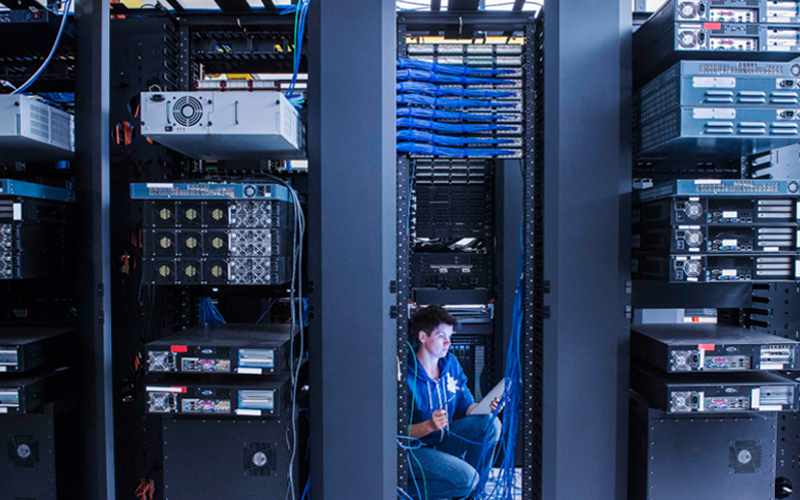Not too long ago, business communication needs were a lot more straightforward and a lot less complex. An in-house phone system would meet virtually every communication need of a business collaborating from a central location. But as technology – and business models with it – has evolved, the days of a phone system supporting a business are long gone. Whether it was
- 1G supporting first mobile calls
- 2G supporting texts
- 3G opening the world of internet access
- 4G that turned our cellphones into powerhouses capable of almost everything
businesses have had to evolve quickly to keep up with the evolving needs and demands of today's hybrid workforce and navigate the multi-channel digital landscape. Modern businesses can no longer afford to work around the limitations of outdated technology in today’s fast-paced world, where employees expect flexibility and remote capabilities and customers expect an omnichannel presence.
Let us explore the new communication technologies that are supporting the next-gen communication needs of modern businesses.
5G supporting next-gen communication services
Although 4G had opened a host of opportunities for businesses to connect with their employees and customers, it faced issues with being overloaded and slower than the quickly evolving communication needs. This is where 5G came into the picture, helping businesses keep up with the evolving demands of accessibility, remote workforces, and hybrid workplaces. 5G is the next generation of communication that is supporting the rapid wave of IoT, AI-powered solutions, and the fourth industrial revolution with its key features, including:
- Faster data speeds
- Lower latency
- Increased capacity
- Improved security
- Enhanced user experience
Boasting speeds up to 100x faster than 4G, 5G networks can facilitate much more data-intensive tasks necessary to support hybrid workplaces.
5G networks also offer significantly lower latency rates, which is a crucial feature necessary for supporting a variety of real-time applications.
As a foundation of next-gen communication, 5G networks can support a much larger number of devices at a time, propelling the widespread adoption of data-intensive solutions like IoT and AI.
Encryption and authentication protocols are inherent to the 5G networks, protecting users against constantly evolving cyber threats.
All the above features combined contribute to an enhanced user experience, allowing businesses to leverage this new communication technology for innovative use cases and groundbreaking new applications.
Overall, 5G networks have not only been a leap in cellular technology but have also revolutionised the way businesses communicate. It has also given rise to next-gen communication solutions connecting businesses effectively with their employees, stakeholders, and customers. Some of these solutions include:
SIP trunking
SIP (or session-initiated protocol) trunking works on a similar principle of a legacy phone system, where a “trunk” of wires connects your in-house phone system to the public switched telephone network. SIP trunks use a digital version of this connection, where it accomplishes the same task as a legacy system over the internet. As a result, you can
- Get enhanced VoIP functionality
- Connect to your business’s phone from any digital device
- Connect with your workforce without physical infrastructure
- Ensure uninterrupted communication
Managed SIP services
Managed SIP (mSIP) services take SIP trunking to the next level, helping businesses connect effectively with their hybrid (or remote) workforce without having to maintain legacy infrastructure. The features and benefits of this cost-effective solution include:
- Proactive monitoring for real-time call statistics
- Guaranteed improvement in voice and call quality
- Redundancy through multiple data centres
- HIPPA verification
Hosted voice services
Hosted voice services or Unified Communications as a Service (UCaaS) can help you consolidate and streamline all your digital communication, offering advantages like:
- Custom solutions for your communication needs
- Real-time advanced business analytics and reporting
- Robust platform supporting diverse networks
- Sharing and integration with team platforms
Voice-enabled teams
Integrating seamlessly with your current communication platform, voice-enabled teams solutions can help you make your workplace more efficient. It offers key benefits like:
- Compatibility with SIP and UCaaS platforms
- Virtually no downtime
- Flexible and affordable solutions
- Unified communication across voice, data, video, and mobile
The choice of communication solution will depend on the communication needs and goals of your business.
Upcoming trends in new communication technologies
Although 5G is driving the next generation of communication, researchers and industry experts are already moving towards the “next big thing”. Some of the most transformative and revolutionary trends in new communication technologies include:
6G network
Although still in the research phase, 6G is expected to perform leaps ahead of 5G. Supporting terahertz frequency bands, integrating intelligent reflective surfaces, and leveraging AI, 6G has potential applications in holographic communication, autonomous vehicles, smart cities, and more.
Quantum communication
Quantum communication leverages the principles of quantum mechanics and uses the properties of quantum particles to encode and transmit information. Relying on the principles of quantum key distribution, entanglement, the no-cloning theorem, and quantum teleportation, it has the potential to revolutionise cryptography, quantum computing, and telecommunication.
These are just two examples of evolving next-gen communication technologies that will transform the way businesses communicate with different stakeholders.
How can Infosys BPM help?
In today’s rapidly evolving business landscape, next-gen communication technologies are playing a pivotal role in helping businesses be agile and competitive. Infosys BPM offers a suite of business process management solutions helping the telecommunication industry keep pace with the evolving new communication technologies and offer cutting-edge services to their customers. With services encompassing Lead-to-Cash (L2C), Trouble-to-Resolve (T2R), Bill-to-Cash (B2C), and service lifecycle management solutions, you can leverage the constantly evolving communication technology to support the evolving business communication needs.








